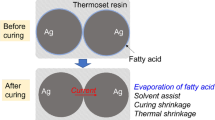Abstract
An anisotropic conductive film (ACF) is a thin adhesive epoxy layer that is widely used to connect circuits in highly-integrated electronic devices. To bind two electric circuits, an ACF is pasted between the circuits and pressed with an optimum pressure so that the joints can be electronically connected. For the curing of the resin, electron-beam (E-beam) irradiation is known to be an environmentally friendly technique and exhibits many technical advantages over conventional thermal curing in terms of low temperature and reduced curing time. In this method, the applied pressure and electron-beam dose are critical parameters to maximize the conductivity without a failing of the connection between the circuits. For the minimization of the contact resistance after curing by using E-beam irradiation, curable epoxy resin was mixed with conductive particles made of Ni/Au-plated polymer spheres with a mean particle size of 10 µm in a ratio of 5: 1 by weight. The mixed resin was pasted on rigid boards having circuits of 100-µm pitch and was irradiated by using an E-beam. The optimum dose for E-beam irradiation for a reasonable curing, the contact resistance values, and the reliability of the cured film were systematically investigated as functions of E-beam dose, applied pressure and temperature. The lowest contact resistance values were obtained when the specimens were irradiated by an 80-kGy E-beam under a constant pressure of 5 kgf/cm2. At this condition, the minimum contact resistance was 80 ± 0.015 mΩ, which is significantly lower than the values obtained from commercial products, and the values were maintained within a 5% increase when the samples were kept at 100 °C for 294 hours. Our results demonstrate that an E-beam irradiation technique can be applied for curing ACFs for commercial electronic devices.
Similar content being viewed by others
References
S. Lee, M. Park, S. Lim and J. Kim, Polymer Sci. and Tech. 16, 48 (2005).
M. Lim and K. Paik, IEEE Trans. Comp. Pack. Manufact. Tech. Part A 21, 226 (1998).
L. W. Dickson and A. Singh, Rad. Phys. Chem. 31, 587 (1988).
F. Guasti and E. Rosi, Composites Part A. 28A, 965 (1997).
A. Singh, C. Saunders, J. W. Bernard, V. Lopata, W. Kremers, T. E. McDougall, M. Chung and M. Tateshi, Rad. Phys. Chem. 48, 153 (1996).
S. Alessi, C. Dispenza, P. G. Fuochi, U. Corda, M. Lavalle and G. Spadaro, Rad. Phys. Chem. 76, 1308 (2007).
T. K. Saha, M. A. Khan and K. M. I. Alit, Rad. Phys. Chem. 44, 409414 (1994).
S. J. Park, G. Y. Heo, J. R. Lee and D. H. Suh, Korean Chem. Soc. 47, 250 (2003).
S. He, K. Shi, J. Bai, Z. Zhang, L. Li, Z. Du and B. Zhang, Polymer 42, 9641 (2001).
J.-W. Kim, Y.-C. Lee and S.-B. Jung, Met. Mat. 14, 373 (2008).
M. A. Uddin and H. P. Chan, Rev. Adv. Mater. Sci. 27, 151 (2011).
M. A. Uddin, M. O Alam, Y. C. Chan and H. P. Chan, Microelect. Reliability 44, 505 (2004).
L. L. Gao, L. Wang, H. Gao, G. Chen and X. Chen, Microelect. Reliability 51, 1393 (2011).
Author information
Authors and Affiliations
Corresponding author
Rights and permissions
About this article
Cite this article
Lee, I., Kim, J. Contact resistance properties of electron-beam-cured anisotropic conductive films. Journal of the Korean Physical Society 63, 1477–1480 (2013). https://doi.org/10.3938/jkps.63.1477
Received:
Accepted:
Published:
Issue Date:
DOI: https://doi.org/10.3938/jkps.63.1477




